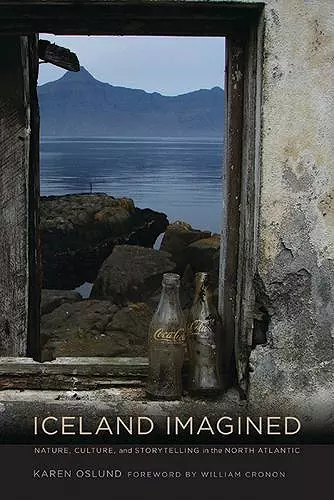Iceland Imagined
Nature, Culture, and Storytelling in the North Atlantic
Format:Paperback
Publisher:University of Washington Press
Published:14th Feb '13
Currently unavailable, and unfortunately no date known when it will be back
This paperback is available in another edition too:
- Hardback£42.00(9780295990835)

The great contribution of Iceland Imagined is to help us understand the mental geographies that over the past quarter millennium have come to define the North Atlantic-and that teach us more than we might think about the rest of the world. -- William Cronon, from the Foreword An excellent work, covering unusual ground. The author's mastery of a variety of contexts-Inuit, Faroese, Icelandic, Scandinavian-and different periods-historical and modern-is admirable. Not only does Iceland Imagined nicely chart important historical contours in the North Atlantic region, it offers numerous useful and original observations on themes in history, anthropology, literature, and linguistics. -- Gisli Palsson, University of Iceland
Details how this marginalized region has gradually become part of modern Europe
Iceland, Greenland, Northern Norway, and the Faroe Islands lie on the edges of Western Europe, in an area long portrayed by travelers as remote and exotic - its nature harsh, its people reclusive. Since the middle of the eighteenth century, however, this marginalized region has gradually become part of modern Europe, a transformation that is narrated in Karen Oslund's Iceland Imagined.
This cultural and environmental history sweeps across the dramatic North Atlantic landscape, exploring its unusual geography, saga narratives, language, culture, and politics, and analyzing its emergence as a distinctive and symbolic part of Europe. The earliest visions of a wild frontier, filled with dangerous and unpredictable inhabitants, eventually gave way to images of beautiful, well-managed lands, inhabited by simple but virtuous people living close to nature.
This transformation was accomplished by state-sponsored natural histories of Iceland which explained that the monsters described in medieval and Renaissance travel accounts did not really exist, and by artists who painted the Icelandic landscapes to reflect their fertile and regulated qualities. Literary scholars and linguists who came to Iceland and Greenland in the nineteenth century related the stories and the languages of the "wild North" to those of their home countries.
". . . compelling and richly detailed . . ."
- Kai Heidemann (H-SAE)"Oslund's comprehensive critical analysis of the narratives and counter-narratives of the gradual evolution of Iceland and the North Atlantic's perceived exoticism into a regulated, normalized part of 'our' world is a valuable contribution to the fields of environmental, cultural and linguistic history, and to Scandinavian scholarship in general."
- John D. Shafer (European History Quarterly)"The narrative moves swiftly and elegantly over unusual grounds. . . . The final chapter discusses two present-day controversies . . . Oslund argues convincingly that in both these controversies stories that travelers had written in the 18th and 19th centuries . . . were retold. In doing so she also demonstrates the present day relevance of studying how Iceland has been imagined in the past."
- Arne Kaijser (Technology and Culture)"The book is well written and detailed. . . . The outcome is a mental journey in the vast and varying region of the North Atlantic, which brings forward surprisingly many details, even for someone raised and living in Iceland."
- Helga Ogmundardottir (H-Environment)"One should read this book for its history of ideas and perceptions and its grasp of the tensions that exist and have existed at cultural frontiers . . ."
- Russell Fielding (Geographical Review)"The book is sure to be of interest to those studying Iceland and the North Atlantic's culture and environmental history and those interested in the European understanding of that region. Summing Up: Recommended."
(ChoISBN: 9780295992938
Dimensions: unknown
Weight: 386g
280 pages